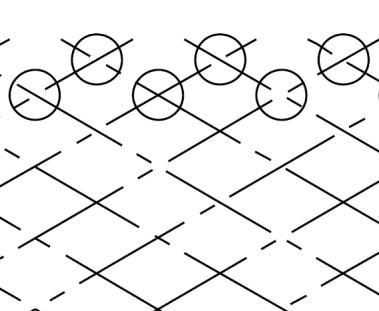2. Assumptions#
The hypotheses accepted in the treatment proposed by the command CALC_MATE_HOMO [U4.43.07] are presented. The three-dimensional heterogeneous solid studied can be:
The three-dimensional « base cell », or also « representative elementary volume », corresponds to a pattern of periodicity with rectangular steps, constituting the geometry of the heterogeneous solid studied:
- in the three spatial directions, for three-dimensional homogenization. The mesh
of the three-dimensional base cell consists of three-dimensional meshes, on which will be assigned isoparametric massive finite elements P1 or P2. As we are restricted to the case of symmetries with respect to the planes of the spatial reference frame, the mesh is limited to the octant of the base cell \((X>0,Y>0,Z>0)\);
- in two spatial directions, and over the half-thickness of the plate, according to the third
spatial direction (we must specify \(X\) or \(Y\) or \(Z\)), for a homogenization such as plate or shell. The mesh of the base cell consists of of three-dimensional meshes, on which massive finite elements will be assigned isoparametric P1 or P2. The dimension of the base cell in the third direction Spatial is used to define its thickness. However, it is possible in the case of a base cell of the plate or heterogeneous shell, to treat a situation of free border in the third spatial direction that constitutes the thickness is not plane: to do this, we will add a fictional material with negligible physical properties in front of those of the other parts of the base cell so as to « fill » these voids to obtain a flat border. As we restrict ourselves to the case of symmetries with respect to the planes of spatial reference, the mesh is limited to the octant of the base cell \((X>0,Y>0,Z>0)\).
Periodic cases with a « hexagonal step » can also be treated by defining a periodic and symmetric « subcell » with a square step.
The base cell, noted \(C\), is therefore bounded by plane borders, see r5.03.37-fig-celluleBase. It is made up of sub-domains each carrying a given material and possibly one or more cavities not meshes: see r5.03.37-fig-reseauPeriodique, which can intersect the borders of the base cell.


The various materials constituting the base cell are defined by characteristics of density, isotropic heat conduction, heat capacity and characteristics isotropic linear thermoelastics, which are defined as functions of variables of command: temperature, or irradiation.
Depending on the case, the homogenized behavior model produced will be:
three-dimensional homogenized linear thermal,
orthotropic three-dimensional homogenized linear thermoelasticity,
- Love-Kirchhoff plate flexion-membrane homogenized linear thermoelasticity, without
flexion-membrane coupling because of the symmetry with respect to the middle sheet.